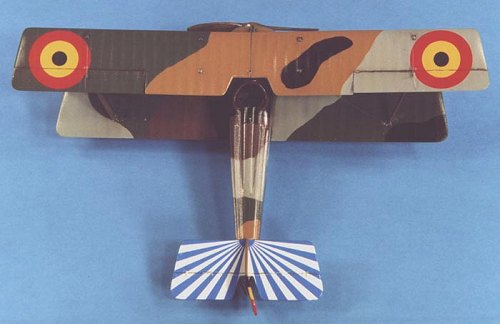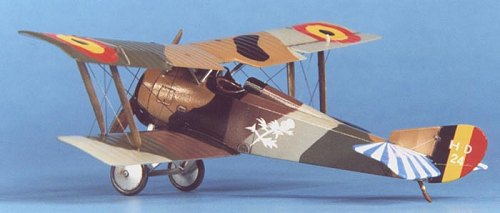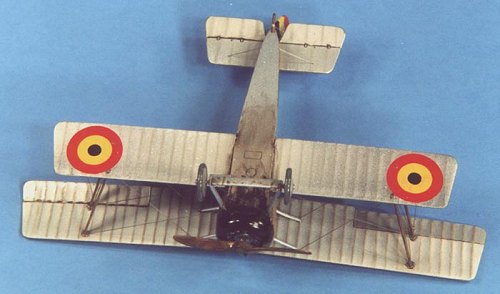
Eduard 1:48 Hanriot HD.I
|
KIT # |
8018 |
|
PRICE: |
$19.95 |
|
DECALS: |
See review |
|
REVIEW : |
|
|
NOTES: |
|

|
HISTORY |
The Hanriot HD.I was supposed to be the follow-on competitor to the successful Nieuport 17 single seat fighter. Unfortunately, it was being developed at the same time as the soon to be famous SPAD 7 and as a consequence it was not ordered into production by the French. The aircraft eventually found its way to both the Italian and Belgian Air Forces where it enjoyed a successful career. Several successful aces such as Willy Coppens who started their careers with the Nieuport fighters preferred the agile Hanriot to other aircraft.
 Born on 6 July 1892 in
Watermaal-Bosvoorde Belgium, Willy Omer Francois Jean Coppens de Houthulst early
military career mirrored that of several successful German aces. First joining
the Army in the 2nd Grenadiers in 1912, he transferred to the
Compagnie des Aviateurs in 1914. In 1916, he began his aerial career flying
two-seaters and shortly thereafter transferred to single-seat fighters. Coppens
earned his first victory on 25 April 1918 shooting down a German aircraft over
St. Joris, but he soon became famous as a "balloon-buster" bagging his
first observation balloon on 8 May. All but three of his 37 victories were over
balloons, making him the highest scoring Belgian ace.
Born on 6 July 1892 in
Watermaal-Bosvoorde Belgium, Willy Omer Francois Jean Coppens de Houthulst early
military career mirrored that of several successful German aces. First joining
the Army in the 2nd Grenadiers in 1912, he transferred to the
Compagnie des Aviateurs in 1914. In 1916, he began his aerial career flying
two-seaters and shortly thereafter transferred to single-seat fighters. Coppens
earned his first victory on 25 April 1918 shooting down a German aircraft over
St. Joris, but he soon became famous as a "balloon-buster" bagging his
first observation balloon on 8 May. All but three of his 37 victories were over
balloons, making him the highest scoring Belgian ace.
Coppens was somewhat of a show-off, often performing aerobatics over the flaming balloon inferno and his penchant for stunting almost cost him his life. Legend has it that on one balloon attack, the balloon unexpectedly shot upwards and lifted Coppens’ HD.I atop it. Coppens calmly shut down the engine to stop the propeller from getting caught in the balloon and it looked like he had actually landed atop it. He calmly waited atop the balloon until his aircraft skidded off and fell, and then restarted his engine after he cleared the balloon. He then lit the balloon afire with his incendiary ammunition for a successful kill!
Unfortunately his successful aerial career ended on 14 October, just before the war’s end. On this balloon attack, Coppens was hit by enemy anti-aircraft fire and struck in the leg. However, he pressed on his attack, scoring his final kill of his career before crash landing inside his own lines. Unfortunately, his leg could not be saved and had to be amputated. Coppens survived the war and eventually retired from the Army in 1940 after serving as a military attaché in several foreign countries.
|
THE KIT |
The kit is Eduard’s Hanriot HD.I kit (8018). It consists of only injected molded plastic parts (54 parts) and decal options for two aircraft, Coppens Belgian 9th Escadrille and an Italian 78 Squadriglia. The plastic parts are high quality injected molded pieces that rivals Tamiya/Hasegawa in quality. The instruction sheet is the usual eight page diagram assembly with marked color painting guidelines, and a cross reference to Tamiya, Humbrol, Revell, Testor, and Aeromaster paints.
|
CONSTRUCTION |
 The first job up was to
cut out the small panel at the rear of the fuselage above the tailskid as shown
on the box top art and add two bracing wires of .005 stainless steel. For some
reason Eduard missed this in the molding of the kit, as most every picture I
have seen of the HD.I has this feature. I also cut off the control surfaces and
then re-attached them with liquid glue to add some animation to the model. I
then pre-painted all the parts as indicated in the instructions. Interior
fuselage walls were painted silver with the stringer detail on the fuselage
sidewalls painted Testor Model Master (TMM) French Chestnut and given a light
wash of burnt umber.
The first job up was to
cut out the small panel at the rear of the fuselage above the tailskid as shown
on the box top art and add two bracing wires of .005 stainless steel. For some
reason Eduard missed this in the molding of the kit, as most every picture I
have seen of the HD.I has this feature. I also cut off the control surfaces and
then re-attached them with liquid glue to add some animation to the model. I
then pre-painted all the parts as indicated in the instructions. Interior
fuselage walls were painted silver with the stringer detail on the fuselage
sidewalls painted Testor Model Master (TMM) French Chestnut and given a light
wash of burnt umber.
Assembly of the fuselage components was accomplished using super-thin superglue. Assembly proceeded as described in the instructions, with no major problems. I especially like the instrument panel decal that even lets a poor painter like myself have a beautiful set of gauges and switches. Since the Hanriot had lightening holes in the seat, I drilled them out by hand using a pin vise. I then closed up the fuselage with liquid cement.
The engine was next as I painted it Metalizer Gunmetal and then drybrushed Metalizer Aluminum on the cylinder heads and crankcase cover. Assembly of the cowl resulted in several gaps, which were filled with putty and then sanded smooth before installation.
Next, I glued with liquid cement the tail fin, horizontal stabilizer, and lower wing to the fuselage. All joins were then sanded smooth, and no putty was required for gap filling. Then I drilled and dry-fitted all of the rigging, strut, and landing gear mounting holes to assist in final assembly as nothing is more frustrating as trying to get these pieces together with a fragile biplane. Next stop was the paint shop.
The model was painted, decaled, and weathered as described in the following subsections and then final assembly took place.
Now it was time to assemble the machine gun as shown in the instructions. I painted the machine gun in Testor Metalizer Gun Metal and dry brushed with Floquil Gun Metal and then superglued to the top of the fuselage.
 I noted a critical mistake
in the instructions with the interplane struts. They are incorrectly numbered
and should be mounted with the more "tapered" strut in the forward
position and the "fat" strut in the rear position. I installed the
interplane and cabane struts into place with superglue and calipers to set the
correct distances and angles using the top wing as a guide.
I noted a critical mistake
in the instructions with the interplane struts. They are incorrectly numbered
and should be mounted with the more "tapered" strut in the forward
position and the "fat" strut in the rear position. I installed the
interplane and cabane struts into place with superglue and calipers to set the
correct distances and angles using the top wing as a guide.
Now onto the fun part, putting on the top wing! Actually, this task went smoothly with no problems. Since the cabane struts are already fixed in the correct position on the fuselage (remember using a caliper to set the actual distance) the top wing snapped into place in the correct position. I used small rubber bands to help hold both wings in place and then checked alignment of the top to bottom wing. When all was to my liking, I superglued the struts to the wing.
Now on to the next challenge, installing the landing gear! Push the pinned legs of the landing gear into the fuselage and set the approximate width of the landing gear axle. Then place the axle into place on the legs and after carefully aligning everything glue it in place Lastly install the painted wheels into place on the axle with superglue, and the tailskid.
Carefully install the propeller with superglue. The propeller and interplane struts were painted by using a base coat of dark yellow, and successive light dry brushing using a rake brush of TMM raw sienna, raw umber, burnt sienna, and burnt umber to replicate the wood grain.
Install all the remaining pieces as indicated in the instructions and rig the model as indicated on the instruction sheet. I used hard music wire in .007 diameter for the rigging, which is a cheap alternative to stainless wire or guitar string.
|
PAINT & DECALS |
 The paint scheme is the
standard French five-color camouflage of dark brown, light green, dark green,
beige, and black over silver-doped linen undersides. Note that the instruction
sheet calls for light gray, which is incorrect. Light green should be
substituted as shown in the box top art. Unfortunately, I did not notice this
mistake until after I painted and decaled the model! DOH!!! I used Testor Model
Master French Chestnut and Flat Black, Humbrol enamel Light Grey (#64) and WWI
Green (#108), and Floquil Military Colors RLM 79. For the undersides I sprayed
an 80:20 mix of Humbrol Metalcote Gloss Aluminum and Light Aircraft Grey (#166).
I used masks cut from 3M Painters Tape, which is a low tack tape available in
2" widths. After the paint scheme cured for a day, I shot a light coat of
Future to prepare the surface for decaling.
The paint scheme is the
standard French five-color camouflage of dark brown, light green, dark green,
beige, and black over silver-doped linen undersides. Note that the instruction
sheet calls for light gray, which is incorrect. Light green should be
substituted as shown in the box top art. Unfortunately, I did not notice this
mistake until after I painted and decaled the model! DOH!!! I used Testor Model
Master French Chestnut and Flat Black, Humbrol enamel Light Grey (#64) and WWI
Green (#108), and Floquil Military Colors RLM 79. For the undersides I sprayed
an 80:20 mix of Humbrol Metalcote Gloss Aluminum and Light Aircraft Grey (#166).
I used masks cut from 3M Painters Tape, which is a low tack tape available in
2" widths. After the paint scheme cured for a day, I shot a light coat of
Future to prepare the surface for decaling.
 The decals supplied with
the kit are not the best. Super thin, super fragile, and they refuse to bend
around corners or into panel lines. Bits of the decals tore and can be seen in
the photos as touch-up paint. I first applied MicroSol setting solution but they
refused to respond and lay down flat. Next was the heavy artillery, Solvaset.
They budged a little but still pretty much refused to lay flat. It took a total
of four applications of Solvaset to get all the decals fully down! After drying
overnight, I wiped the decals off with a moist cloth with Pollys Plastic Prep to
remove any residue and after drying I shot a very light coat of Future thinned
with rubbing alcohol (50-50 mix) over the decals to seal them. For weathering, I
chose to accentuate the engraved panel lines and surface detail with a light
burnt umber oil wash.
The decals supplied with
the kit are not the best. Super thin, super fragile, and they refuse to bend
around corners or into panel lines. Bits of the decals tore and can be seen in
the photos as touch-up paint. I first applied MicroSol setting solution but they
refused to respond and lay down flat. Next was the heavy artillery, Solvaset.
They budged a little but still pretty much refused to lay flat. It took a total
of four applications of Solvaset to get all the decals fully down! After drying
overnight, I wiped the decals off with a moist cloth with Pollys Plastic Prep to
remove any residue and after drying I shot a very light coat of Future thinned
with rubbing alcohol (50-50 mix) over the decals to seal them. For weathering, I
chose to accentuate the engraved panel lines and surface detail with a light
burnt umber oil wash.
I then sealed everything with a light coat of PS Flat Finish to provide a surface for pastel application. I then used a pastel pencil to lightly highlight the rib detail on the wings/tail surfaces. I then randomly applied some ground up burnt umber pastels with a soft brush to simulate dirt staining on the lower surfaces. Lastly, I applied a heavy burnt umber oil wash to the wheels and control surface joins.
I then finished final assembly of the models as described above. Finally, several coats of straight Future was shot to achieve the final glossy finish common to most WWI aircraft.
|
CONCLUSIONS |
This is an excellent model of an important WW I aircraft. Overall the quality and accuracy are exceptional. The level of detail engraved in the kit is a great improvement over previous generation Eduard models, and no after-market sets are really needed for a beautiful build. I highly recommend this kit for all levels of builders including beginners. For those modelers that have built Eduard kits in the past and swore them off due to the poor fit and construction problems, this model will definitely change your opinion.
|
REFERENCES |
Albatros Productions LTD, Windsock Datafile #12, Hanriot HD.I, $14.00
Copyright ModelingMadness.com. All rights reserved. No reproduction in part or in whole without express permission.
If you would like your product reviewed fairly and quickly, please contact the editor or see other details in the Note to Contributors.